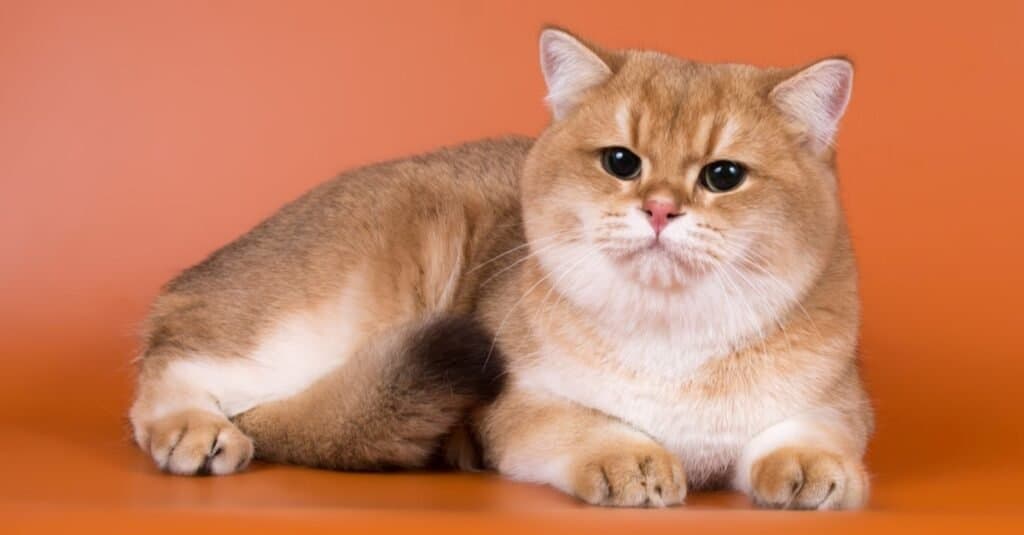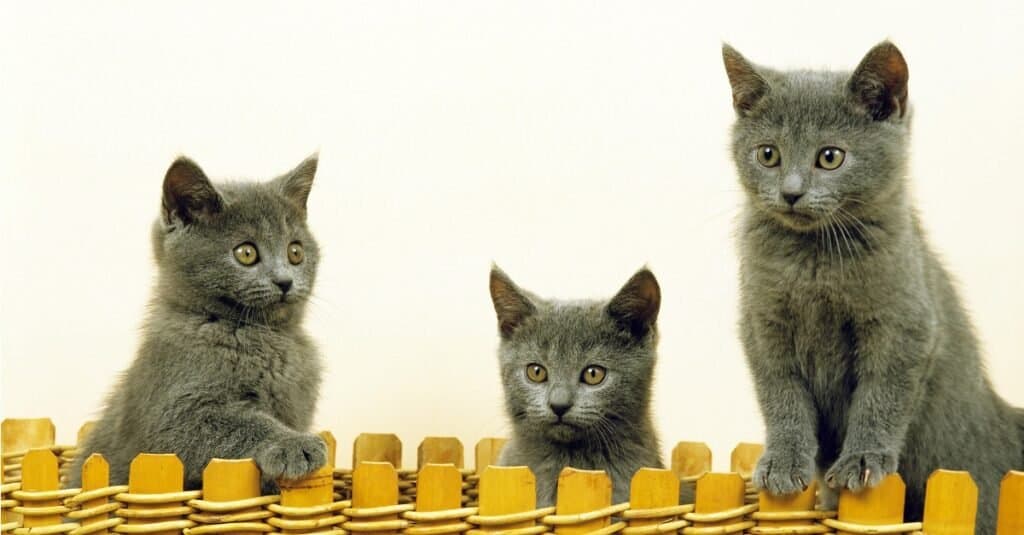Chartreux and British Shorthair cats are very similar in appearance. These cats are both solidly built, with thick solid-grey fur and copper or amber eyes. However, although these cats share similar traits, they are very different from each other. In this article, we will explore their differences and compare some similarities between the Chartreux cat vs. British Shorthair cat.

Chartreux Cat vs. British Shorthair – Heights are 16 and 14 inches, Weights are 11 and 18 pounds, and lifespans are 15 and 20 years at the upper end, respectively.
©iStock.com/filippo_87
| Chartreux Cats | British Shorthair Cats | |
|---|---|---|
| Scientific name | Felis Catus | Felis Catus |
| Height | 12 – 16 inches | 12 – 14 inches |
| Weight | 9 – 11 pounds | 9 – 18 pounds |
| Lifespan | 11 – 15 years | 9 – 20 years |
| Colors | Blue or silver grey | Tabby, blue, chocolate, white, red, black, tortoiseshell, and lilac |
| Coat | Thick and woolly | Thick and dense |
Chartreux Cat vs. British Shorthair Cat: Size
Chartreux cats have narrow faces and slim legs with stocky bodies. They are much more compact and lither than the British Shorthair cat. There is also a significant weight difference between males and females. Females usually weigh as little as 9 pounds and males as much as 11 pounds.
British Shorthair cats have lovely chubby faces with short stubby legs. They are muscular cats and continue to grow into their adult weight until the age of five. Females can weigh anything from nine to 11 pounds and males from 11 to 16 pounds. Their weight and chunky bodies make for cats that are difficult to miss!
Chartreux Cat vs. British Shorthair Cat: Behavior
The Chartreux cat is friendly and affectionate, often displaying affection by rubbing against or “hugging” you. In addition to their caring natures, they are active cats and love playtime. Consequently, they often engage in more “doglike” activities, like playing fetch. They are mischievous cats and often get stuck in precarious situations.
Chartreux cats are extremely intelligent and master escape artists. They will quickly figure out how to open doors or windows to get outside or how to open the treat cabinet’s door. Because they are so adventuresome, ensure that you cat-proof all outside doors and windows and lock the cabinet doors to avoid encouraging unwanted behavior.
These cats have friendly, outgoing personalities but are incredibly loyal. So, once they choose their person, they may become clingy and, in turn, be coy around strangers. Likewise, Chartreux cats love nothing more than hugs and lap time, so be sure you want the same thing.

British Shorthairs are intelligent, affectionate, and do not have a temperamental side. They are tolerant of children and dogs, making them excellent family cats.
©OksanaSusoeva/Shutterstock.com
The British Shorthair is a more aloof cat, preferring to lie close to you rather than on your lap. As a result, they are more independent than the Chartreux cat. However, their aloofness doesn’t mean they are not loving, just more reserved. Consequently, British Shorthair cats are very caring and loyal in their quiet way.
Chartreux Cat: Children and Dogs
The Chartreux cat has an affectionate nature and enjoys an active lifestyle. This energetic nature makes them a good fit for homes with dogs and children. Moreover, their playful and lively personalities attract children, especially those who appreciate nothing better than cuddling and playing with a cat. However, they can be anxious and skittish around aggressive dogs but will engage in play with calmer dogs.
You should always supervise small children and toddlers around cats. The idea is to guide children in handling and playing with these felines carefully. Unfortunately, no matter how patient the Chartreux cat may be, they will lash out if a child provokes them, as will most pets, resulting in unpleasant outcomes.
British Shorthair Cats: Children and Dogs
The British Shorthair cat does well in homes with dogs and children, showing remarkable patience and being slow to become irritated. Because of their patient demeanor, the British Shorthair prefers to remove herself from a situation they don’t like.
Like the Chartreux cat, you should supervise toddlers and smaller children around the British shorthair cat. As a result, you will minimize the risk of injury as they won’t always be patient if children try and hurt them. However, older children generally do well with the British Shorthair cat as it is easier for them to understand that they don’t appreciate children hugging and picking them up.
The British Shorthair cat gets along with dogs and might even be friendly. But, they will remove themselves from the vicinity of an over-friendly dog if it intrudes on their personal space.

British shorthair and
golden retriever
on computer
©iStock.com/chendongshan
Chartreux Cat: Care and Maintenance
The Chartreux cat, like any other, needs access to clean litter boxes. Pet owners should clean their teeth regularly, at least twice a week. And because these felines have thick fur, you should comb them at least once a week.
It is important to remember that Chartreux cats are very energetic. But they can become destructive if left alone for too long. Because of their energetic nature, you can provide them with suitable toys to keep themselves busy when you’re not available. However, make a point of spending time with them as they prefer to spend time playing with their humans.
Additionally, Chartreux cats are obliging and trainable, but become distressed and upset if you punish them. So, if you do give them training, be patient and reward them with treats when they perform well.
Feed them high quality wet food and plenty of water to prevent the formation of kidney stones. If you do give them dry food, do so sparingly, if at all.

Chartreux kittens reach adulthood around three years of age, are energetic. trainable, love their owners, and are prone to kidney stones.
©slowmotiongli/Shutterstock.com
British Shorthair Cat: Care and Maintenance
The British Shorthair is a much bigger cat than the Chartreux. Because of their size, you should give them a bigger litter box and the play equipment should also be bigger to accommodate their size. And in terms of grooming, brush their thick, woolly fur every week or so to ensure no knots form. Additionally, experts recommend that you brush their teeth regularly to prevent dental issues.
It’s also important to note that British Shorthairs can often be an expensive breed of cat costing up to $2,000.
Engaging your British Shorthair cat in play is important for their physical and mental wellbeing. Ideal toys include flirt poles, which are excellent choices for these cats, as they engage their hunting instincts and encourage movement. Similarly, you can use puzzle toys that dispense treats to stimulate their mental interest.
As your British Shorthair cat gets older, they can become lazy. It is important to keep engaging them in play to ensure they get enough exercise to maintain their weight and agility.
Unfortunately, the British Shorthair is prone to renal problems. Due to renal problems, you should feed them a wet diet and provide them with plenty of water. Keep dry food to a minimum or only use as treats.
The photo featured at the top of this post is © iStock.com/vvvita
Thank you for reading! Have some feedback for us? Contact the AZ Animals editorial team.






